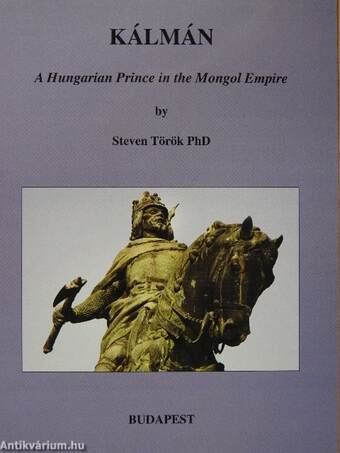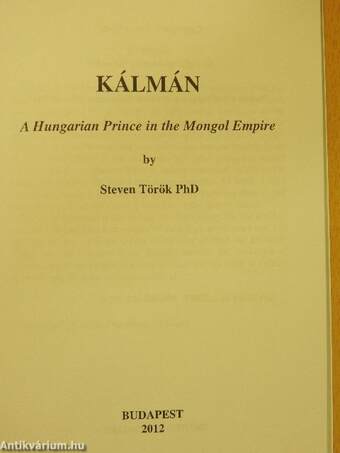1.063.490
kiadvánnyal nyújtjuk Magyarország legnagyobb antikvár könyv-kínálatát

VISSZA
A TETEJÉRE
JAVASLATOKÉszre-
vételek
Kálmán
A Hungarian Prince in the Mongol Empire
naponta értesítjük a beérkező friss
kiadványokról
naponta értesítjük a beérkező friss
kiadványokról
Fülszöveg
Statue of Prince Kálmán in
front of the former
Premonstratensian priory,
now housing the University
of Agriculture in Gödöllő,
by József Róna (1931)
During the darkest days of communism,
Steven Török PhD, a Hungarian-born teen-
ager, several times passed the statue of
Kálmán (see photograph), which stood in
front of his school in Gödöllő, Hungary.
Prince Kálmán, younger brother of the Hun-
garian King Béla IV, disappeared in the battle
of Muhi in 1242, when the Hungarian army
fought against the biggest force of the time,
the Mongol Golden Horde led by Batu Khan,
grandson of Genghis Khan. Though the battle
was lost, and afterwards the Mongols pun-
ished Hungary by killing half of the popula-
tion, the Mongol army was also weakened so
much that marching towards the West they
reached no further than Vienna. This is why
Hungarians think that their sacrifice saved
Europe from the Mongol invasion.
In his day-dreams, Steven imagined that
Kálmán did not die; he... Tovább
Fülszöveg
Statue of Prince Kálmán in
front of the former
Premonstratensian priory,
now housing the University
of Agriculture in Gödöllő,
by József Róna (1931)
During the darkest days of communism,
Steven Török PhD, a Hungarian-born teen-
ager, several times passed the statue of
Kálmán (see photograph), which stood in
front of his school in Gödöllő, Hungary.
Prince Kálmán, younger brother of the Hun-
garian King Béla IV, disappeared in the battle
of Muhi in 1242, when the Hungarian army
fought against the biggest force of the time,
the Mongol Golden Horde led by Batu Khan,
grandson of Genghis Khan. Though the battle
was lost, and afterwards the Mongols pun-
ished Hungary by killing half of the popula-
tion, the Mongol army was also weakened so
much that marching towards the West they
reached no further than Vienna. This is why
Hungarians think that their sacrifice saved
Europe from the Mongol invasion.
In his day-dreams, Steven imagined that
Kálmán did not die; he may have been
wounded, but escaped alive, and perhaps he
reached as far as Siberia, similarly to hundreds of thousands of Hungar-
ians after the World War II, never to return.
The 1956 revolution against the Soviets found Steven as a first-year
student in Physics at the University of Debrecen, travelling to villages,
spreading the news. When the revolution was crushed, he had to leave
Hungary to escape punishment. He went to the United States, which be-
came his second home country, where he finished his studies, obtained
his PhD, and also a scholarship to Japan, where he married. Later he lived
in the US, London, and Bangkok, but he never forgot Kálmán. In retire-
ment he studied Eastern history, and wrote this interesting story from
which the reader may feel the winds of the history blowing from both the
13th and the 20th century, riding on a horseback together with Kálmán. Vissza
Témakörök
- Idegennyelv > Idegennyelvű könyvek > Angol > Szépirodalom > Regény, novella, elbeszélés
- Szépirodalom > Regény, novella, elbeszélés > Tartalom szerint > Életrajzi regények > Történelmi személyiségek > Magyarok > Egyéb
- Szépirodalom > Regény, novella, elbeszélés > Az író származása szerint > Magyarország
- Szépirodalom > Regény, novella, elbeszélés > Tartalom szerint > Történelmi regények > Középkor > Egyéb








